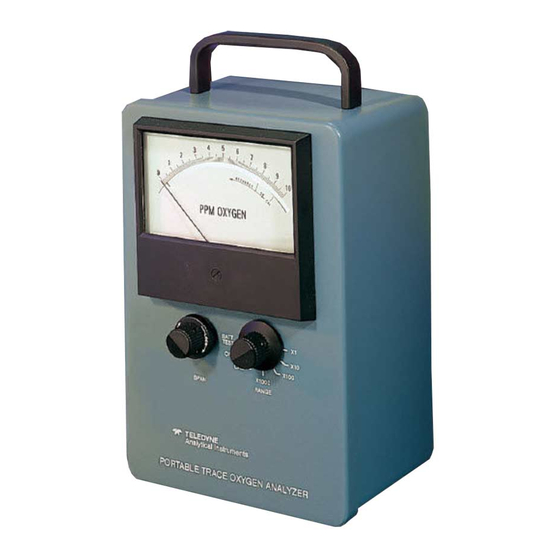
Table of Contents
Advertisement
Advertisement
Table of Contents

Summary of Contents for Teledyne 311
- Page 1 www.teledyne-ai.com...
- Page 2 WARNING The sensor(s) used in this instrument uses electrolytes which contain substances that are extremely harmful if touched, swallowed, or inhaled. Avoid contact with ANY fluid or powder in or around the unit. What may appear to be plain water could contain one of these toxic substances.
-
Page 3: Table Of Contents
TABLE OF CONTENTS MODEL 311 INTRODUCTION Description Method of Analysis Outstanding Features 1.3.1 Micro-Fuel Cell 1.3.2 Reliable Calibration 1.3.3 Integral Power Supply 1.3.4 Accuracy and Response 1.3.5 Compact Packaging SUPPORTING EQUIPMENT AND SERVICES Sampling Equipment Power Service OPERATION Introduction Calibration 3.2.1 Air Calibration Procedure... -
Page 4: Model 311
MODEL 311 TRACE OXYGEN ANALYZER INTRODUCTION Description: The Teledyne Analytical Instruments (TAI) Model 311 is a portable, intrinsically safe trace oxygen analyzer which can be operated without an external power source and reliably calibrated without the use of cumbersome, questionable, so-called “certified”... -
Page 5: Reliable Calibration
Only when the selector switch is placed in the OFF position will the neon lamp on the back plate of the Model 311 light up to indicate power to the battery charging circuit. * U.S. Pat. Nos. 3,767,552 and 3,668,101... -
Page 6: Accuracy And Response
This means that the Model 311-C may be used in explosive atmospheres where arcs of 100 milliwatts or less can be tolerated. The Model 311 meets Factory Mutual approval requirements as intrinsically safe for Class I, Division I, Groups A, B, C and D hazardous locations. -
Page 7: Supporting Equipment And Services
An eight (8) foot, UL approved, 3-wire detach- able power cord is provided with the instrument and should be stored in a safe place when not in use. As a no cost option the 311 can be furnished with 220 volt, 50 or 60 Hertz charging power. -
Page 8: Operation
OPERATION Introduction. The Model 311 is supplied completely assembled and ready for instant use. The Micro-Fuel Cell is in place within the manifold, and prior to shipment the mani- fold was purged with an inert gas to eliminate all but traces of oxygen from the internal sampling system. - Page 9 Stand the instrument upright on a level surface, and with the range switch in the “OFF” position, check the alignment of the meter pointer with the zero mark on the scale. Use the mirror to eliminate parallax, and adjust the screw on the face of the meter, if necessary, until the pointer and zero mark are in precise coinci- dence.
-
Page 10: Standard (Span) Calibration Procedure
3.2.2 Standard (Span) Gas Calibration (optional) Gas required: - Zero gas - (70-90%) of full scale of the primary (working) range NOTE: If the primary (working) range is a lower range, when you change to a higher range recalibration is a must for accuracy (see Figure 2 Chart, included). -
Page 11: Atmospheric Pressure Sampling
Before making any connections to the instrument, establish a flowrate in the sample line of from 0.1 to 10 liters/min. Allow the sample to vent to accomplish long enough to purge the line free of air. Install the vent fitting first, and then the sample source fitting. Be prepared to make the connections in rapid order, so that atmospheric diffusion time through the vent fitting is held to a minimum. -
Page 12: Maintenance
MAINTENANCE Battery Power Supply Service. The Model 311 is designed to be intrinsically safe, and therefore is for use ONLY when it is not connected to the AC power line. TAI suggests that an overnight recharge be accomplished every four (4) weeks of continuous use. To recharge the batteries, place the range switch in the “OFF”... -
Page 13: Cell Warranty
After the cell has been installed, purge the instrument with an inert gas (or the sample), and then proceed as directed in Section 3.2.1. Cell Warranty. The Class B-2C cell employed in the Model 311 is warranted for 80,000 percent-hours or six (6) months of service (whichever occurs first). -
Page 14: Transduction And Temperature Compensation
WARNING: Evidence of damage due to tampering or mishandling will render the cell warranty null and void. TRANSDUCER AND TEMPERATURE COMPENSATION The Micro-Fuel Cell has an inherent positive temperature coefficient, the effects of which have been minimized through the implementation of a calibrated thermistor compensation circuit. Internal electronic calibration is accomplished by TAI. - Page 15 Procedure II: Purge the instrument with Nitrogen at the sample port. Note the reading once it has stabilized (at least 24 hrs. on the 0-10 ppm range) and increase the flow rate. If the reading goes down, the unit, or the tubing to the unit, has a leak. -12-...
-
Page 16: Specification Data
±1% at constant temperature Reproducibility: Sensor Type: Class B-2C System Power Requirements: Model 311 - AC power for battery recharge circuit of two current limited rechargeable NiCad batteries, 115 VAC, 50/60Hz (100/220 VAC optional). Weight: 6 lb (2.71 Kg.). Approval: Intrinsically Safe (Class I, DIV. -
Page 17: Spare Parts List
RECOMMENDED SPARE PARTS LIST MODEL 311 QTY. DESCRIPTION F-51 MICRO-FUSE, 0.25 AMP., FAST-BLOW (FOR 210-240 VAC) F-39 MICRO-FUSE, 0.25 AMP., FAST-BLOW (FOR 100-125 VAC) C6689 -B2C MICRO-FUEL CELL, CLASS B-2C C6689-A2C MICRO-FUEL CELL, CLASS A-2C (CO2 applications) B-9905 BATTERY L-79 LAMP METER. -
Page 18: Drawing List
DRAWING LIST MODEL 311 B-9271 PICTORIAL DIAGRAM C-14463 SCHEMATIC C-14627 WIRING DIAGRAM NOTE: The MSDS on this material is available upon request through the Teledyne Environmental Health and Safety Coordinator. Contact at (626) 934-1592. -15-...











Need help?
Do you have a question about the 311 and is the answer not in the manual?
Questions and answers